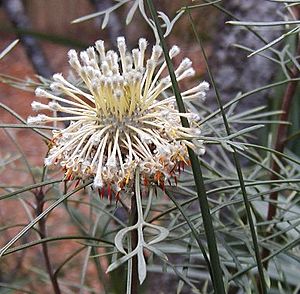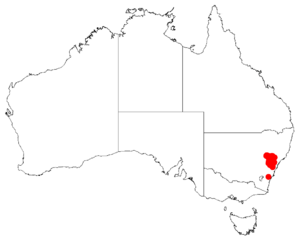Nepean conebush facts for kids
Quick facts for kids Nepean conebush |
|
|---|---|
 |
|
| Isopogon dawsonii in Glenbrook | |
| Scientific classification | |
| Genus: |
Isopogon
|
| Species: |
dawsonii
|
 |
|
| Occurrence data from Australasian Virtual Herbarium | |
The Nepean conebush (scientific name: Isopogon dawsonii) is a special type of shrub found only in eastern New South Wales, Australia. It belongs to the Proteaceae plant family. This plant is known for its unique leaves, which look like feathers, and its creamy yellow or greyish-white flowers that grow in round clusters.
Contents
What Does the Nepean Conebush Look Like?
The Nepean conebush usually grows as an upright shrub. It is often about 1 to 3 meters (3 to 10 feet) tall, but some can grow as tall as 5 or 6 meters (16 to 20 feet)! Its branches are reddish-brown. When the plant is young, its small branches and leaves are covered with soft, greyish hairs.
The leaves of the Nepean conebush are quite interesting. They are called "pinnate," which means they look a bit like a feather, with many narrow parts branching off a main stem. These leaves are usually 8 to 12 centimeters (3 to 5 inches) long.
The flowers grow in round clusters, about 4 to 4.5 centimeters (1.5 to 1.8 inches) across. These clusters are "sessile," meaning they attach directly to the stem without a stalk. The flowers themselves are creamy yellow to greyish-white and are covered in dense hairs. They are about 1.5 to 1.8 centimeters (0.6 to 0.7 inches) long.
This plant blooms in spring. After flowering, it produces small, hairy, oval-shaped fruits called "nuts." These nuts are fused together to form a round cone, about 1.5 to 1.8 centimeters (0.6 to 0.7 inches) in diameter.
How Did It Get Its Name?
The Nepean conebush was first officially described in 1895. A scientist named R.T. Baker wrote about it in a scientific paper. He used notes from another famous botanist, Ferdinand von Mueller, who had not yet published his own work on the plant.
The plant's scientific name, dawsonii, was given to honor James Dawson. He was a person from Rylstone, who likely helped with the study of this plant.
Where Does the Nepean Conebush Live?
The Nepean conebush grows naturally in eastern New South Wales, Australia. You can find it on slopes made of sandstone and near cliff edges. It likes to grow in areas with "heathland" (open, shrubby land) and "dry sclerophyll forest."
It lives in the valleys of the Goulburn and Nepean Rivers. You can also find it in areas like the Central Coast, the Central Tablelands, and the Western Slopes, reaching down to Lithgow.
Growing Nepean Conebush
If you want to grow a Nepean conebush, you can start it from seeds. You can also grow it from cuttings, which are small pieces taken from a healthy plant's new growth.
This plant is quite tough! It can grow in many different conditions. It is also "drought hardy," meaning it can survive periods without much water. It is also "frost hardy," which means it can handle cold temperatures and frost. Some people have even used this plant's roots to help grow other types of Isopogon plants from Western Australia.


